Our Leadership
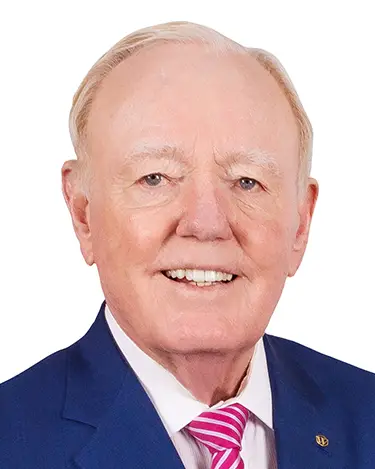
Get to know…
Don O. Walsworth
Don Walsworth is CEO and Chairman of the Board at Walsworth, the 26th largest printing company in the U.S. and a top yearbook, magazine, catalog and book printer. His father started the company in 1937, and Don officially joined after college. At the helm of the company since 1967, Walsworth has experienced significant growth under his leadership in both yearbook printing and commercial printing. He is well known for his abundant optimism; love of family, Linn County and Mizzou; strong business acumen; and fierce pride in remaining a family-owned business that supports the Walsworth team, customers and communities.
To start, Don, we wanted to chat about the history of the company. Can you tell us a little about the early days of the company?
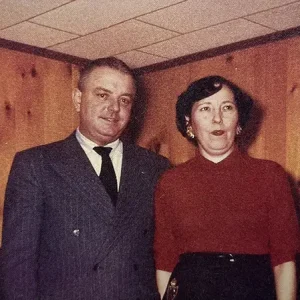
The company originated with my mother and dad. After they were married, my mother put on hometown shows for schools and churches, and my dad would sell ads in the program for the play.
Then he started printing the programs for the plays, and it’s what evolved into our printing company. His two brothers joined the company, and we were known as Walsworth Brothers for many years.
During World War II, we started doing various history books for towns. We did war memorial books for the soldiers, sailors and Air Force, and became a big cookbook company.
My dad was used to selling advertising for the plays, so he came up with the idea of also selling advertising for the yearbooks. They would sign a school up for their yearbooks and wouldn’t charge them anything. The reps would generally go to a smaller town with larger towns around it and sell ads. That paid for the yearbooks, which the school would then give to the students. This went on for quite a few years and was really the start of when the company started growing.
I remember them talking about changing to what they called the “cash deal,” which is when we started charging the school for the yearbook and the schools started selling the ads to help pay for the books. That’s how the yearbook industry really evolved.
The ad sales initially were more to the community, as opposed to directly to the school or to the parents?
Yes, it was altogether different than what it is now.
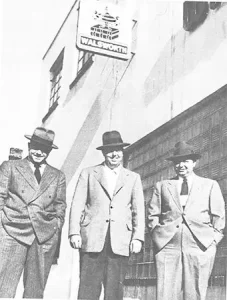
My first memory of them printing the books was using a photographic method, so every print had to be developed. It had developer, and you had hypo to stop the development. My first job with the company was to shake the hypo jugs, and I hated that. It was terrible, but that was my job. Every other day after school I’d come up to the plant and have to shake the hypo jugs.
Then we had two little Davidson 8 ½ x 11 offset presses. We printed the yearbooks there, and also the church books, the cookbooks.
My dad was very satisfied with it, and I can remember at one time we had 110 cars on the road. My dad had a deal with the Ford dealer here in Marceline and Boonville, and we were able to buy cars when they were really difficult to buy.
We would have ad sellers going into all these towns, and the reps were selling advertising for the cookbooks and the War Memorial books. I remember my uncles every Friday getting telephone calls from about 6 in the evening until 9 or 10 that night. And that’s when the company really got to growing.
After that, the war ended, and we moved downtown here in Marceline.
I remember that we had a couple Paris presses, and when my dad bought a two-color press, it was the biggest press I’d ever seen. I couldn’t believe there was a press that big and printing two colors at a time. From there, we started printing some four-color. I remember we did the University of Wyoming book. That was the first big order we had. We’d have to put two colors down and then run it back through to put the other two colors on. From there, our yearbook printing took off.
While I was in college, both of my parents passed away and my two uncles helped run the company while I finished school at the University of Missouri. Upon graduation in 1957, I joined my uncles at the company.
That year, we had about 700 cookbooks to print and really didn’t have any money. Edgerton Welch was a banker in Chillicothe, Missouri. I played basketball, and he kind of he liked that. He came to most of my games, and he gave me a loan. At that same time, he asked me to be on his board and wanted to be my mentor. He was really a brilliant guy.
The deal was I had to talk to him for at least an hour to two hours every day. He was going to teach me the banking business. Well, we talked more about Missouri football and basketball than we did about banking. But I did learn the banking business, and I went on to become the largest shareholder and Chairman of the bank.
By 1967, I was leading our company and knew we had to grow if we were going to survive. I was trying to build a company, and I was trying to invest as best I could. We had to take out some high interest loans, but we were able to pay them back.
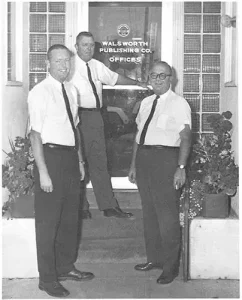
Around then, I became president of the National Yearbook Association. At that time, there were 17 companies represented by our association. I got to know some really wonderful people. Bill Taylor with Taylor Publishing Company, Andy Marston, I knew the people in Kansas City with Myers. Although we were competitors, we all got along really well. And of course, we never did grow very much, but everybody was pretty well satisfied with what they did. Taylor was out of Dallas, and they had more business than all the rest of the other 16 companies together. And although the association dissolved after a couple of years, I have a plaque in my office when I became President. I really cherish that plaque.
Over time, the company started doing really well. I met with our employees and said, if we can ever get to $25 million in yearbook sales, we’re going to be one really great company. Lo and behold, last year we did over $100 million. You can’t believe how big a deal that is. For a little company, that started out with nothing and grew and grew and finally did what we did – $100 million in yearbooks. That’s just incredible. I didn’t think I’d ever see that in my lifetime. Combined with the growth we’ve realized on our commercial side of the business, Walsworth is larger than any of us could have imagined.
What do you think has been key to our growth?
I don’t want to take the credit because I’ve been very fortunate to be able to attract some of the best men and women in the printing industry. My son Don joined the company in 2000, and he’s now the President of the company. He and I agree that you hire the best people you possibly can and let them do the job, don’t micromanage them and have a little entrepreneurship.
Early on, one of the biggest philosophies I developed is that you can’t lay off your people; you’ve got to keep them full time. That’s when we got into commercial printing, because I knew we had to maintain our workforce. You couldn’t train people every year to be proofreaders or film strippers or pressman and then let them go. By printing other items, we could keep our people working on other projects when yearbooks weren’t printing.
On the commercial side, we’ve made several acquisitions. We just bought a company in Eau Claire, Wisconsin. We’re going to have Inkjet now, which is huge because we’re now able to be a complete print solution for our customers. We’ve previously purchased and integrated companies in Fulton, Missouri; Saint Joseph, Michigan; and Ripon, Wisconsin. We have the Marceline plant and the Brookfield plant. We’re right on the verge of hitting the $300 million overall, and that’s because we have good people, and we let them do their job.
Our guiding philosophy is that we’re never going to sell this company. We’re dedicated to so many great employees and our communities because we wouldn’t be where we are today if it wasn’t for them. We have an obligation to a lot of families. I’ve always felt this way, and Don has too. And now Tripp, the fourth generation, feels that way. So, with that philosophy, we are able to attract some really great people, because they know they’re going to have a stable job. They know the company’s growing, and the people they’re working with are really professional.
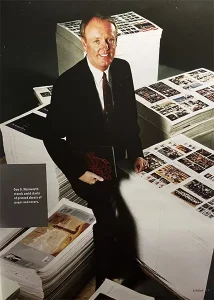
With all the consolidation in both the yearbook industry and in printing in general, what sets Walsworth apart?
I think the printed book is going to be here for many, many years. A lot of people thought with the internet and all, that the printed book wouldn’t be around very long. Well, that’s not true at all. Our catalogs right now, we’re doing more catalogs than we ever did. We’re doing more youth books, baby books, that kind of thing. A mother or grandmother doesn’t want to hold a baby and get their iPad or the computer out. They want to have a book to read to that child. Books tell stories and preserve memories.
A lot of people think catalogs will go online, but they haven’t. We have some of the biggest customers in the United States. People want to look at the catalog, be able to read it, pass it around, and it’s kind of the same thing with books.
We’re doing so many books for major companies across the U.S., just a whole litany of different industries we’re printing for. And again, the reason we’re able to grow and prosper is because of the wonderful employees we have. We’re just so fortunate to be able to attract these kinds of people.
Our people are happy, and that’s a good thing. You know, nobody wants to work for a company that’s not doing well. Our success in our acquisitions has been that we don’t buy a bad company – we buy a good company and make it better. We want to be a good employer to their teams and want them to do well.
And I’m not saying we’re out of the acquisition mode, because we’re really not. We want to grow and prosper not only for the company, but also for our fine employees.
Can you tell me a little bit about what it’s meant to have Tripp join the company?
As a family-owned company, the fourth generation is incredibly important to us. We keep telling our people we’re not going to sell the company, but I think this just solidified it. This company is going to be around for a good many more years.
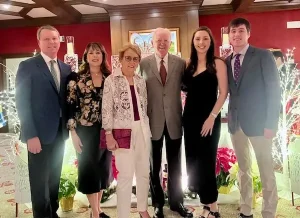
And you know, I’ve seen it so many times in the banking business – generally two generations is about all a company has. Now we’re going into the fourth, and I think that’s indicative of the people we have and the company we’ve all built together.
Tripp has a lot to learn about the industry and our company. He knows that, and he’s dedicated his life to being a Walsworth executive. I know he’s being received well. He’s a hard-working guy and really dedicated, and he’s working well with the people in our organization. That’s the most important thing.
And the thing about it is, we didn’t want him to come right out of college. He needed to see the real world. He worked for Lockton for three years and did an unbelievable job. A top Lockton executive called Don and said, “You’ve got a winner here.” That really made us proud. We’re just so happy to have him here.
What role did your mother play in the company?
I can remember a lot of times my mother and my two aunts would have to come in and work in the proofreading or in the film stripping department. That’s when we used to arrange and join the film negatives in pictures. They worked here during yearbook season because it needed to be done.
It kind of reminds me of a couple years ago during COVID, and our salespeople came and worked at the plant. I mean, that brought back fond memories to me of everyone pitching in. It felt like old times.
A good thing about that is they left understanding the book manufacturing business a lot better. And really, without them coming in, I don’t think we would have had the delivery we did.
You know, we’ve had unbelievable delivery the last couple of years. Two years ago, we were 100% on time. Last year, we had one book that wasn’t on time out of around 6,000 schools but that was more of a shipping issue. We are committed that we’re not going to deliver a yearbook late. We’re just not going to do it.
What do you think your father and mother would think if they saw the business today?
I think it would be more than their imagination could handle. I really do. In their day, a company this size was just unbelievable, particularly in the rural towns like we’re mostly in. I’m certain they’d be amazed and really happy.
When customers or prospects think of Walsworth, what word do you hope comes to mind?
Security. What I mean by security is we’re going to produce the product for the price we quoted. It’s going to be the quality they anticipated, and it’s going to be delivered on time to meet their schedules.
So really, what we’re selling is security in both yearbook and commercial printing, which is so important. Our customers deserve it.
Can you talk about what the communities of Marceline and Brookfield mean to you, and what they’ve always meant to the company?
Our first plant was in Marceline, and we were starting to outgrow it by a lot. Brookfield came to us and said, we’d like to have you occupy this building over here. It had been the Brown Shoe factory. We’ll give it to you if you have so many people employed for so many days, months of the year. And we agreed to that.
And the first time I went to look at the plant, I thought, that’s an enormous building. We’ll never fill that up. How wrong I was. Brookfield and Marceline been very good to us.
We’ve always been committed to the communities we’re in. We want these communities to do well, and we do everything we can to help them.
It’s no secret you’re very involved with University of Missouri. Can you talk a little about what the school has meant to you and the relationship you have with them?
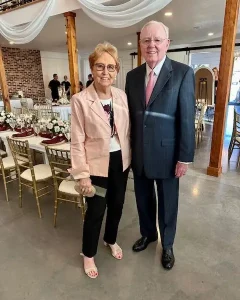
Yes, the University of Missouri is very important to Audrey and me, and I’ve been very fortunate to be involved in the university quite a bit. I’ve been on the board of curators for seven years and was President of the Board of curators for two years, plus being on a lot of committees.
I’ve been very active in the athletic department for the last 15 years as well, including being on the committee to hire the basketball and football coaches and athletic directors. That’s been a really exciting committee.
Audrey is a world traveler – at one time she was the only woman in the world who had been to every country (193) and all 327 Travelers Century Club (TCC) territories. She has a scholarship program at the Business School where the students can travel abroad to third world countries. We generally help finance 20-40 students a year to go on these trips. It’s an endowment she continually funds – the Audrey Walsworth Foundation. It’ll go on forever.
You mentioned your three essentials of life earlier. Can you tell me about them?
There’s three essentials of life that I’ve lived by for many, many years – you’ve got to have something to do. You have to have something to love. And you have to have something to hope for. If you don’t have any one of those things, you’re out of balance. I think it’s really important and this has helped me be successful. I hope others hearing this will analyze these three areas within themselves.
Outside of work, what are your hobbies?
They keep thinking I’m gonna retire, and I’m not. I like to play golf, but I don’t live to play golf, and I like to duck hunt. Those are my two hobbies, I guess you’d say.
Frankly, my wife keeps telling me I need a hobby. I’m not going to be taking up woodworking or anything like that. That’s just not my bag.
You’ve always been very healthy. I know you used to be a runner, and you still currently walk quite a bit, right?
I do two and a half miles about every morning. I walk at a fast pace now and then I jog for about 100-125 yards hard as I can. And you’ve got to remember, I used to run six miles. Then I finally got it down to three miles, and now I’m doing two and a half miles.
It’s not very pretty, but I do it. If you think I enjoy getting up at six o’clock every morning working out, you’re wrong. I hate it, but I do it every morning.
You’ve always been an open book, but is there a fun fact about you most don’t know?
Well, you know, I’ve spent a few days in Florida, and I’m not a big Florida guy. But I generally go down for two weeks, play golf and kind of come back and forth.
All my friends down there are fisherman, and they’re trying to make a fisherman out of me. They go out 80 miles. And my deal is, when I go out 80 miles, I get seasick. Then when they catch a fish, the captain brings it back and tells us all about the fish, and I’m about ready to get sick, but I can’t. They just don’t give up. They still want to make me a fisherman but it’s not going to happen.
I know you don’t drink coffee, but if you had a personalized mug for your tea, what would it say?
People make the difference. (Editor’s Note: We have those exact coffee mugs throughout the office.)
Do you have a favorite moment or memory from your time here at the company?
I really do. Reaching $100 million in yearbook sales is unbelievable. It’s something I thought would never happen. You can’t believe how difficult it’s been, and how much our salespeople, our manufacturing people and the entire team working together made that happen. I can’t thank the team enough for what they’ve done – it’s been a remarkable job. If I had to say one highlight of my career – that’s a highlight right there. Now that it has, it’s just a wonderful feeling to know that we have men and women who dedicated themselves to grow this company in that area, and they’re still growing. That’s a wonderful thing.
One last question for you. Tell me about these crystal frogs on your desk.
You know what a frog can’t do? A frog can’t jump backwards. A frog always goes forward. I’ve given those to so many people. I’ve probably given 5,000 of those frogs out to athletic directors, coaches all over the country, to bankers, to industry leaders, and I’m certain that I’ve got 50-75 frogs on people’s desks. I look at those every day. You can’t go backwards.

